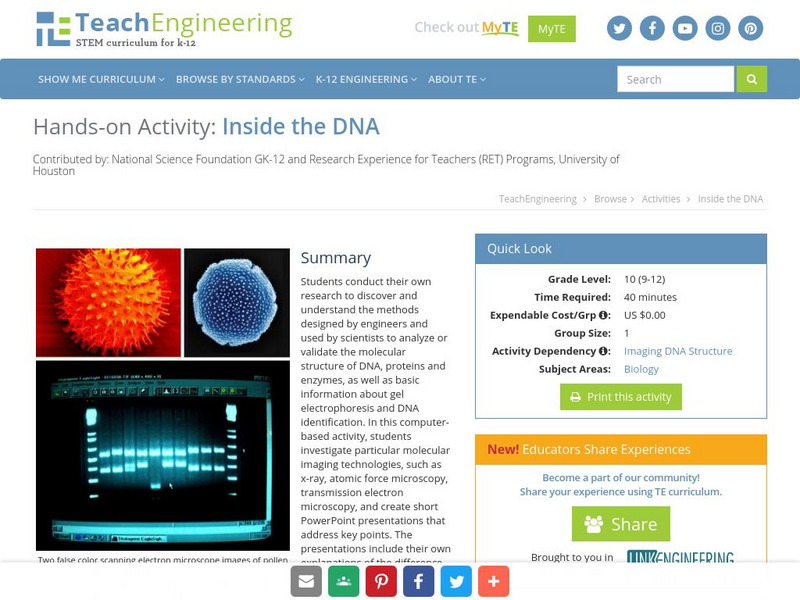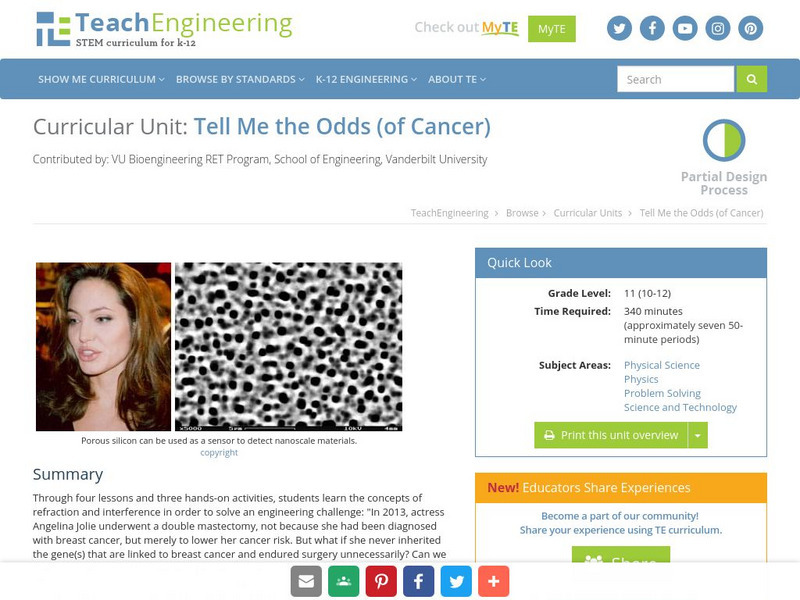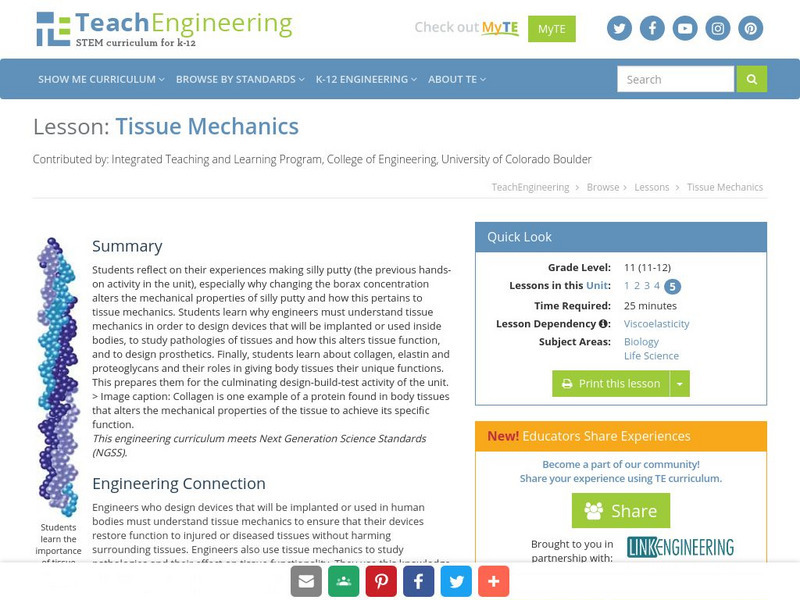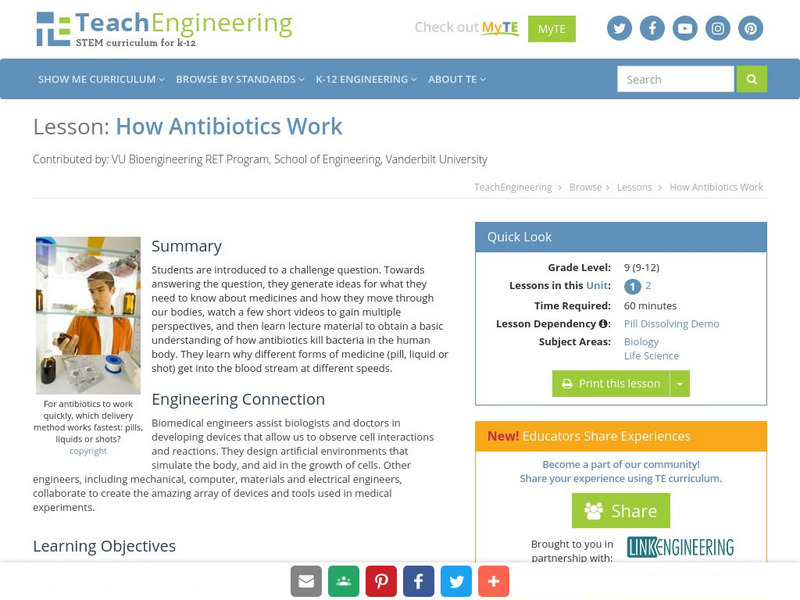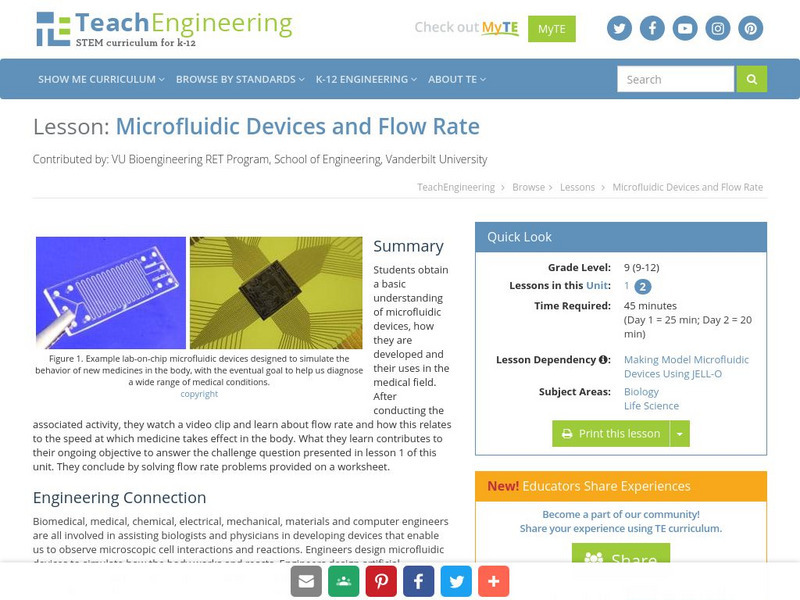Curated OER
We've Come a Long Way, Baby!
Students study technology and the different reproductive technologies available today. In this human reproductive technology lesson students describe how engineers create technologies to improve the health of mothers and babies.
Curated OER
Biomedical Devices for the Eyes
Students study the structures of the human eye. In this eye device lesson students examine different eye problems and devices that can help to resolve them.
Curated OER
Breathe In, Breathe Out
Students study the respiratory system, the lungs and air. In this respiratory lesson students describe technologies that engineers have found that improve the health of the respiratory system.
Curated OER
Circulation
Students define the functions of the circulatory system. For this body circulation lesson students see how engineers have involvement with the circulatory system.
Curated OER
Digestion Simulation
Students study the human digestion system and the functions of the stomach and small intestines. In this digestion lesson students view a demonstration on the process.
Curated OER
DNA: The Human Body Recipe
Students describe DNA and the roles in which engineers are involved with the human body. In this DNA lesson students participate in a class demonstration.
Curated OER
Launch Biotechnology into Your Classroom: Drug Delivery and Diffusion
Young scholars distinguish between diffusion and osmosis and describe ways that drugs can be administered. In this diffusion lesson plan students research career paths and create a presentation to give to the class.
TeachEngineering
Teach Engineering: Watch Out for the Blind Spots
In this service-learning engineering project, students follow the steps of the engineering design process to design a hearing testing device. More specifically, they design a prototype machine that can be used to test the peripheral...
TeachEngineering
Teach Engineering: Using Hooke's Law to Understand Materials
Students explore the response of springs to forces as a way to begin to understand elastic solid behavior. They gain experience in data collection, spring constant calculation, and comparison and interpretation of graphs and material...
TeachEngineering
Teach Engineering: Measuring Viscosity
Students calculate the viscosity of various household fluids by measuring the amount of time it takes marble or steel balls to fall given distances through the liquids. They experience what viscosity means, and also practice using...
TeachEngineering
Teach Engineering: Preconditioning Balloons
Students use balloons (a polymer) to explore preconditioning a viscoelastic material behavior that is important to understand when designing biomedical devices. They improve their understanding of preconditioning by measuring the force...
TeachEngineering
Teach Engineering: Inside the Dna
Students conduct their own research to discover and understand the methods designed by engineers and used by scientists to analyze or validate the molecular structure of DNA, proteins and enzymes, as well as basic information about gel...
TeachEngineering
Teach Engineering: Tell Me the Odds (Of Cancer)
A seven-lesson unit where students learn the concepts of refraction and interference in order to solve this engineering challenge: In 2013, actress Angelina Jolie underwent a double mastectomy, not because she had been diagnosed with...
TeachEngineering
Teach Engineering: Viscous Fluids
Students are introduced to the similarities and differences in the behaviors of elastic solids and viscous fluids. Several types of fluid behaviors are described--Bingham plastic, Newtonian, shear thinning and shear thickening--along...
TeachEngineering
Teach Engineering: Tissue Mechanics
Students reflect on their experiences making silly putty (the previous hands-on activity in the unit), especially why changing the borax concentration alters the mechanical properties of silly putty and how this pertains to tissue...
TeachEngineering
Teach Engineering: How Antibiotics Work
Students are introduced to a challenge question. Towards answering the question, they generate ideas for what they need to know about medicines and how they move through our bodies, watch a few short videos to gain multiple perspectives,...
TeachEngineering
Teach Engineering: Microfluidic Devices and Flow Rate
Students obtain a basic understanding of microfluidic devices, how they are developed and their uses in the medical field. After conducting the associated activity, they watch a video clip and learn about flow rate and how this relates...
TeachEngineering
Teach Engineering: Blood Pressure Basics
Students study how heart valves work and investigate how valves that become faulty over time can be replaced with advancements in engineering and technology. Learning about the flow of blood through the heart, students are able to fully...
TeachEngineering
Teach Engineering: Tell Me Doc, Will I Get Cancer?
Students are introduced to the challenge called, Tell Me the Odds, discovering a new way to assess a person's risk of breast cancer. Solving this challenge requires knowledge of refraction and the properties of light.
TeachEngineering
Teach Engineering: Quantifying Refraction
Students learn the relevant equations for refraction (index of refraction and Snell's law) and how to use them to predict the behavior of light waves in specified scenarios.
The Association of the British Pharmaceutical Industry
Abpi: Cloning
An in-depth look at cloning and the technology behind it. Students work through interactive learning material, understanding the ethics involved in all types of cloning. There is a suggested classroom activity and a self-checking quiz at...
National Institutes of Health
National Center for Biotechnology Information: Welcome to Ncbi
The National Center for Biotechnology Information advances science and health by providing access to biomedical and genomic information.
Other
Exxon Mobile: Be an Engineer
Where can an engineering degree take students? Read the stories of innovative thinkers and engineers.













